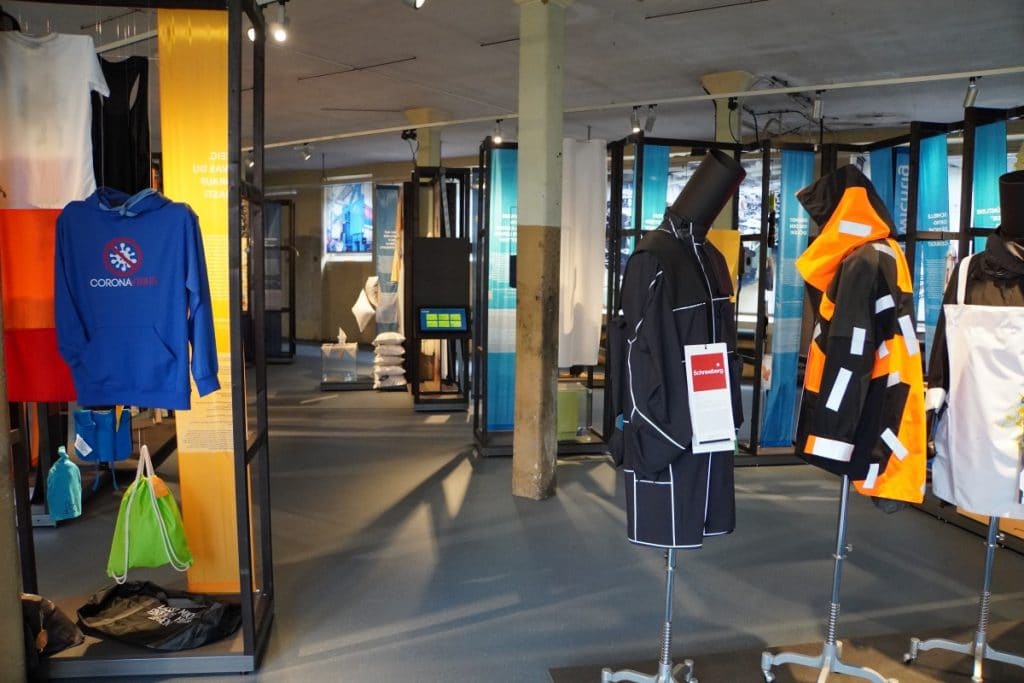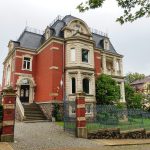The Pfau cloth factory is located in the Saxon textile town of Crimmitschau near Zwickau. Here you can learn about textile production from the spinning mill to the weaving mill.
Crimmitschau was a successful textile town for many years. In addition to cloth factories and spinning mills, working-class districts and manufacturers’ villas still characterise the townscape today. The Pfau cloth factory had a lasting influence on life in the town for many years. Today, the factory is an industrial monument and museum, which we were able to explore on a guided tour.

History of the Pfau Cloth Factory
Friedrich Pfau founded a hand weaving mill in Crimmitschau in 1859. Soon more capacity was needed and a new four-storey factory building with boiler house and chimney was built. This made it possible for all production steps in the manufacture and processing of coating yarns to take place in one factory.

In 1899 there was a fire and a large part of the factory was destroyed. Friedrich Pfau handed over the business to his sons Otto and Adolph, who now rebuilt the company under the name “Geb. Pfau”. The factory owner’s villa, into which Otto Pfau moved, and a representative administration building were also built. The neighbouring spinning and dyeing mill was bought in 1916, doubling the production area.

During the world wars, the cloth factory produced military cloth. The order situation even made it possible to purchase new machines during the Second World War. After the Second World War, production was used to pay reparations to the Soviet Union. From 1947, it was possible to produce for domestic needs again. At that time, they produced cloth for men’s and women’s outerwear, coat and suit fabrics and costume and skirt fabrics.
From 1957 onwards, under state ownership and later from 1972 onwards as a state-owned enterprise of the GDR, the company produced almost exclusively cloth for other countries in the West. The seven Crimmitschau textile factories were merged to form VEB Volltuchwerke Crimmitschau.
The political and economic turnaround and outdated production facilities led to the cessation of production and closure of the factory in 1990. 200 employees lost their jobs.

A museum is being created
After production ceased, the entire site, including the machines, was placed under a preservation order. Fortunately, this prevented the machines from being demolished and scrapped.
A support association was founded and the city acquired the site. In 1996, the first renovation work began and shortly afterwards the town joined the new Zweckverband Sächsisches Industriemuseum (Saxon Industrial Museum Association).

Parts of the museum were modernised in the course of the Saxon State Exhibition 2020 and presented the setting “Textile”. Today, visitors can take part in guided tours.
A small interesting fact on the side:
When you enter the entrance area of the museum, you immediately notice the many new lockers. I was a little surprised by the numbering of the lockers. At first glance, the sequence of numbers makes little sense. But at second glance and with the locker door open, it quickly becomes clear. They are year numbers! In the lockers, you learn something about the history of the region and the Pfau cloth factory that matches the year.


Tour through the Pfau cloth factory
To tell you straight away, I have never found it so exciting to see old machines. This was certainly due to the fact that although I have no idea about cloth production, the tour is led by a real specialist. Former employees guide visitors through the Pfau cloth factory. Our guide, who had worked for the company for 36 years, showed his enthusiasm for his profession and was able to give an excellent insight into the production process and his former field of activity.
If you go on a tour here, you will experience the production from the raw wool to the finished cloth. Every single step is explained and some of the machines are even shown in full operation to demonstrate a process.
Rolling
The first area of the museum we were able to enter is also the first processing step of the delivered raw material. The purchased fibres are torn and pulled in huge machines called carding mills. This process is called wolfing.

The aim of the process is, quite simplified, to process the large fibre piles into small fibre flocks and to align the fibres of these flocks. The process is repeated several times and finally a kind of fleece is produced. This is then formed into a round band in another machine, the so-called roving.

In the Pfau cloth factory there are several of these machines, which are equipped with huge rollers. Even here you could guess what was to come. The machines are really impressive.

Spin
The roving is now further processed in several steps in spinning columns.


Here, too, are countless machines, all of which were busy making a solid yarn/thread by distorting and twisting. A small film shows how workers were busy putting on empty cardboard tubes, which then wound the thread. The noise level in the room was quite considerable.

Twisting the thread or twisting is the last step before the finished yarn is now rewound onto large rolls.
One of these machines was turned on during our tour. The twisting of the thread was so fast that the naked eye could not keep up.

Weaving
Before the fabric can be woven, the warp threads are made. These are the threads that are clamped lengthwise in a loom. These threads not only have to be as long as the fabric will later be, they also have to be colour sorted for patterned fabrics. What a crazy machine to use for this. The pinning of the coloured threads was done by hand according to a pattern template. If a mistake crept in, the whole fabric was later rejects.

In another huge hall are the looms. Not the kind of looms where you sit comfortably and the shuttle pulls the thread. Here are 30 large machines at which the workers stood during a twelve-hour working day. One of these machines has been turned on for us and immediately there is a deafening noise in the hall. The looms rattle at 114 decibels and I am glad that we only have to endure a “taste” of the noise. No wonder there are hearing problems at this workplace. The speed with which the shuttles are shot through the warp threads is impressive. It happens so fast that you can hardly follow it with the naked eye.

The machines were also able to weave patterns. Of course, not with the help of modern computer technology. Here, people worked with punched cards that indicated the order in which the weaving yarn was used.
In some of the looms, there are pieces of cloth hanging. Some have really beautiful patterns and I can very well imagine what was sewn from them.
Finishing processes
The finished fabrics are then rolled in different machines depending on the type of fabric. This type of fabric finishing results in a felting of the fibres.
Now they can still be re-dyed in the dye works as needed. This area can also be visited at the Pfau cloth factory.

Before shipping, the fabrics are washed and dried. Then the fabrics are rolled up or baled and sent to the customer.
The tour of the Pfau cloth factory also ends with this process.
Special exhibition at the Pfau Cloth Factory: Textile? Future!
Those who want more information on the subject of cloth can visit a special exhibition before or after the tour. It is located on the first floor of the former spinning mill. Here you can take a look at the present and the future of the textile industry.

A wide variety of fabrics made of different fibres and their uses are presented. The focus is not only on functional clothing or workwear, but also on innovative products. The issue of sustainability is not forgotten.

Of course, there are also reports on professions and career prospects. Because, as in so many specialised professions, there is a lack of local talent.
Address:
Leipziger Straße 125
Eingang Sahntalstraße
08451 Crimmitschau
Opening hours:
Friday – Sunday, public holiday: 10 am – 5 pm
Guided tour with advance booking 2 pm
Admission fees:
Adults: 5,-€
Discounts are offered.
Disclosure: The visit to the Pfau cloth factory was part of a rights trip to Zeitsprungland. This article was written independently of the visit.










Leave a Reply